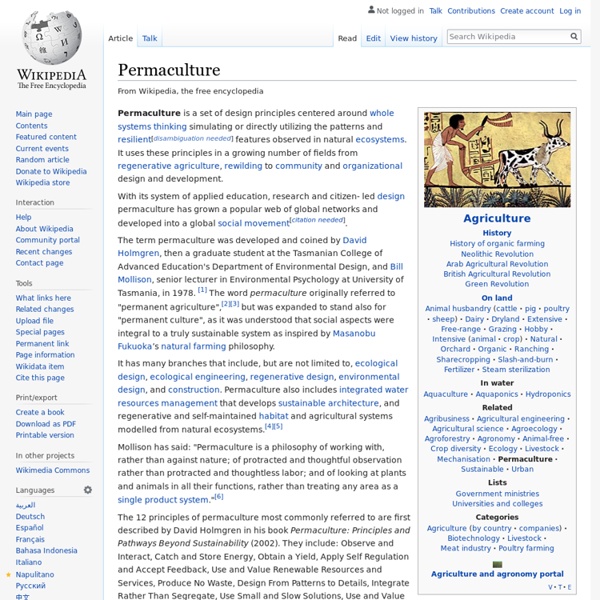Recycling animal and human dung is the key to sustainable farming
© Illustrations in red & black: Diego Marmolejo for low-tech magazine. The innocent looking water closet breaks up a natural cycle in our food supply. Basically, it turns extremely valuable resources into waste products. When we grow crops, we withdraw essential nutrients from the soil: potassium, nitrogen and phosphate, to name but the most important.
Bill Mollison
Bruce Charles 'Bill' Mollison (born 1928 in Stanley, Tasmania, Australia) is a researcher, author, scientist, teacher and Biologist. He is considered to be the 'father of permaculture',[1] however Joseph Russell Smith, was the first to write about a system of Permanent Agriculture in a book entitled Tree Crops, published in 1929.[2] Permaculture is an integrated system of design, Mollison co-developed with David Holmgren, that encompasses not only agriculture, horticulture, architecture and ecology, but also economic systems, land access strategies and legal systems for businesses and communities. In 1978, Mollison collaborated with David Holmgren, and they wrote a book called Permaculture One. Bill Mollison founded The Permaculture Institute in Tasmania, and created a training system to train others under the umbrella of Permaculture.
Bega: BEND - Bega Eco-Neighbourhood Developers
Bega Eco-Neighbourhood Developers Inc. is a not-for-profit Incorporated Association that formed in December 2002. It aimed to purchase a particular site on which to develop a working ecologically and socially sustainable urban housing neighbourhood where people of diverse socio-economic status can flourish. This is essentially complete, with a series of Lots in the eco-subdivision passing into the ownership of future residents in March and April 2009. Much has been done and achieved - explore the relevant tabs above to see how our various project teams and objectives progressed. Last Block
Trophobiosis
Trophobiosis is a symbiotic association between organisms where food is obtained or provided. The provider of food in the association is referred to as a trophobiont. The name is derived from the Greek τροφή trophē, meaning "nourishment" and -βίωσις -biosis which is short for the English symbiosis.[1] In mutualistic relationships, the production of honeydew by trophobionts is rewarded by removal of dead hemipterans and protection from a variety of predators by the attendant ants.
DIY $2 self-watering garden bed - Grow produce easily, even in the toughest drought conditions - NaturalNews.com
Thursday, June 26, 2014 by: Carolanne WrightTags: self-watering garden bed, sustainable agriculture, drought conditions (NaturalNews) "When life gives you lemons, share them with neighbors!" enthuses the Food is Free Project, a grassroots organization based out of Austin, Texas. The project isn't advocating sharing bad luck; instead, it's championing the idea of connecting neighbors and communities with a bounty of free, homegrown fresh produce.
Urban Eco-villages Group In Melbourne
Neil Simpson, Phil Gall, Sandy King, Vasko Drogriski (Australia) [Conference Day 2 @ 19:30 - Submitted Paper] It tends to be assumed that urban living entails having to live with urban blight: traffic choked roadways; polluted air and watercourses; suburban sprawl and alienated social environments. Less obvious is the extraordinary inefficiency of cities in dealing with energy needs, the supply of resources such as food and materials, the disposal of waste and the fact that private transport contributes significantly to greenhouse gas emissions. The Local Agenda 21 Document agreed to at the 1992 Rio Earth Summit stipulates that 'development' and the protection of the environment cannot be separated. Many financiers are no longer investing in the more dysfunctional cities, and there is now a world-wide movement seriously looking at radical solutions to the urban crisis.
Using Agroforestry to Save the Planet
Agroforestry—the use of trees in farming—benefits both farmers and the environment. According to a recent report by Biodiversity International, the Center for International Forestry Research, the World Agroforestry Centre, and Charles Sturt University, forests contribute to the livelihoods of more than 1.6 billion people. Yet, 30 percent of the world’s forests are used primarily for the production of wood products. Agroforestry is defined as the integration of trees and shrubs into crop and animal farming systems. These practices can help landowners diversify products and create social, economic, and environmental benefits.
A Best-Practices Guide to Growing Tomatoes: Tomato Basics
Attention to the basic needs of tomatoes goes a long way toward keeping them healthy and productive. If you’ve had problems with tomatoes in the past, the solution is probably in this list. Light. Plant tomatoes where they get 8 hours or more of sunlight daily. Any less will reduce the harvest. Soil.
How to Grow an Endless Supply of Garlic Indoors
Other than being one of the healthiest food out there, garlic is also easy to be grown indoors. It is also a much cheaper way than buying it at the grocery store, and of course much healthier. You’ve all heard of the amazing benefits of garlic and all the things it can do for your body, so let’s just jump to how to grow it in the comfort of your own home. How to Grow Garlic Indoors
How the round, bee-friendly Sun Hive may help save the bees (Video)
There's ongoing debate in the backyard beekeeping community about which type of hive offers the best balance between what the bees need and honey production. From top bar to Warré, there are plenty of different hive designs, each with its benefits and peculiarities. Made with "bee-centred" apiculture and conservation in mind, the Sun Hive is an alternative format for natural beekeepers. Created by German beekeeper and sculptor Guenther Mancke, the Sun Hive is a based on the form of hives as found in the wild. Made with bees in mind



